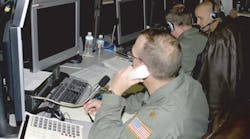Boeing selects Northrop Grumman for C-17A avionics redesign
Officials at Boeing in Seattle have chosen experts at Northrop Grumman Corp.'s Navigation Systems division in Woodland Hills, Calif., to provide refreshed technology and upgraded software for the warning and caution and the mission computer subsystems on Boeing's C-17A aircraft. Under the development phase of this program, Northrop Grumman will create new software, test equipment, and qualification units that will be flight-tested by Boeing in the spring of 2004. The production phase of the contract will result in the creation of 43 shipsets of line replaceable equipment with deliveries beginning in the first quarter of 2005. The potential value of the development and production phases of the contract is $45 million. The new units are form, fit, and function replacements for the older technology systems. They will introduce modern hardware and jointly developed software certifiable to Federal Aviation Administration DO-178B, which will meet international aircraft operational flight requirements.
Rockwell Scientific launches electron beam lithographic services
Engineers at Rockwell Scientific Co. LLC (RSC) in Thousand Oaks, Calif., recently introduced direct write Electron Beam Lithographic (EBL) services. The services are supported by RSC's new JEOL JBX 6000FS/E machine, which has 20 nanometers minimum line width for standard services. Custom services are available for line widths smaller than 20 nanometers. Specific EBL services include: direct writing onto Si, GaAs, InP, SiC, and GaN substrates of sizes ranging from pieces of wafers to full 4-inch wafers; writing FET device structures onto a variety of substrates of various sizes; and patterning gratings and lenses onto various substrates. The JEOL JBX 6000FS/E machine is installed in the RSC Electronics Division clean room facility, which is an ISO 9001 process lab. The JEOL operates at 25 or 50 kilovolts. Multiple chucks are available for wafer sizes from 2 inches to 150 millimeters. Direct write overlay and field stitching accuracies of less then 50 nanometers are typical. For more information contact Rockwell Scientific on the World Wide Web at http://www.rockwellscientific.com.
AVX Corp. designs MIL-qualified tantalum capacitors
Officials at AVX Corp. in Myrtle Beach, S.C., recently began offering additions to its CWR09 and CWR11 military tantalum chip capacitor families to satisfy increasing demand for higher capacitance MIL-qualified components, company officials say. The CWR09 style, commercially available as the TAZ Series, provides flexibility in surface mount capacitors with eight case sizes to cover the full capacitance/voltage range. The CWR11 style, commercially available as the TBJ Series, is designed to EIA standard sizes, using common board layout designs shared with commercial products. The CWR09/TAZ series are fully interchangeable with CWR06 conformal types. The molding compound used for these capacitors has been selected to meet the requirements of UL94V-O and outgassing requirements of NASA SP-R0022A. The CWR09 design offers compliant terminations, which decouple board stresses from the capacitor element, providing reliability through mounting and reflow processing. The CWR11 series encompasses four case sizes and is fully qualified to MIL-PRF-55365/8, the military version of EIA-535BAAC and the commercial industry standard. For more information on AVX's tantalum chip capacitors, contact AVX sales and marketing by phone at 843-946-0414, by fax at 843-626-5186, or on the World Wide Web at http://www.avxcorp.com.
U.S. Monolithics to develop HPA for military satcom aboard ships
Officials at ViaSat recently selected U.S. Monolithics in Chandler, Ariz., to develop and build a 200-watt High Power Amplifier (HPA) for use with seagoing military satellite communication terminals. The new HPA will be integrated with ViaSat RT-1829 UHF Demand Assigned Multiple Access (DAMA) terminals for use aboard ships. ViaSat has outstanding orders for 40 RT-1829 terminals from the French and Canadian Navies and the NATO Consultation, Control, and Command Agency under an ID/IQ contract from SPAWAR. Development is expected to be completed early this year. The USM HPA is designed to be three rack-units high and will integrate several off-the-shelf components, plus a USM-designed custom controller card. For more information on US Monolithics contact the company on the World Wide Web at http://www.usmonolithics.com.
Systran Corp. introduces high-speed, protocol-transparent VME switch
Systran Corp. experts in Dayton, Ohio have designed the LinkXchange LXVME2500 crossbar switch as an addition to its family of crossbar switches. The LXVME2500 is a managed, non-blocking crosspoint switch implemented on a 6U VME64X card. The LinkXchange LXVME2500 is capable of switching digital signals ranging from 65 megabytes per second to 3.2 gigabytes. The protocol or structure of data routed through the switch is transparent to the LXVME2500 and is unaltered by its passage through the switch. The base switch includes eight switched ports. An expansion card, which attaches directly to the base switch and occupies a second VME slot, supports an additional 8 ports. A single LXVME2500 switch includes eight Small Form-Factor Pluggable (SFP) transceiver modules. Each module provides the physical ports for one input-output pair. Different types of SFP transceiver modules support varying data rates and formats. The switch also enables simultaneous support for different types of transceivers, providing easy media conversion. For more information contact the company on the World Wide Web at http://www.systran.com.
PTC to provide software and services to Raytheon
Officials at Raytheon in Lexington, Mass., recently awarded experts at PTC in Needham, Mass., a $10.4 million multi-year follow-on order for software upgrades, new modules, and services. Raytheon's government, defense, and commercial electronics businesses have standardized on PTC's flagship software, Pro/ENGINEER and its family of related technologies, for product design and development. The new software will be used to support Raytheon's global initiatives in an international network of 34 sites, spanning three continents. Raytheon's corporate product development initiatives are designed to help deliver systems with lower costs and improved lifecycle supportability, company officials say. For more information on PTC contact the company on the World Wide Web at http://www.ptc.com.
DARPA selects BAE Systems to lead C4ISR program
Officials at The Defense Advanced Research Projects Agency (DARPA) in Arlington, Va., have selected BAE Systems to lead the Advanced Concept Technology Demonstration phase for its Adaptive Joint C4ISR (Command, Control, Communications, and Computer, Intelligence and Reconnaissance) Node (AJCN) program. BAE Systems Information & Electronic Warfare Systems (IEWS) in Nashua, N.H., received initial funding as prime contractor for the program. IEWS will provide management and systems engineering leadership and will lead the signals intelligence, electronic attack, and systems integration efforts. AJCN, formerly the Airborne Communications Node, will provide a scaleable, multi-functional, multi-mission communications, signals intelligence, and electronic attack payload that can be reconfigured to perform a variety of functions in the same processing hardware. The U.S. Army and U.S. Air Force will be key users of the C4ISR node. BAE Systems will design, build, and deliver four flyable payloads that provide the warfighter with communications relay and bridging, signals intelligence and electronic attack. Two payloads will be flight-tested on the Army's Hunter unmanned air vehicle and the other two will be flight-tested aboard either an Air Force KC-135 or RC-135 aircraft. For more information contact BAE Systems IEWS on the World Wide Web at http://www.baesystems-iews.com.


